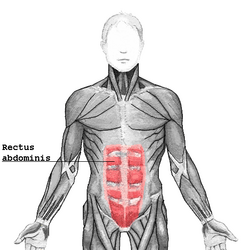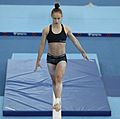Rectus abdominis muscle facts for kids
Quick facts for kids Rectus abdominis |
|
|---|---|
 |
|
| The human rectus abdominis muscle. | |
| Latin | musculus rectus abdominis |
| Artery | inferior epigastric artery |
| Nerve | segmentally by thoraco-abdominal nerves (T7 to T11) and subcostal (T12) |
The rectus abdominis muscle, also known as the "abdominal muscle" or "abs", is a paired muscle running vertically on each side of the anterior wall of the human abdomen, as well as that of some other mammals. There are two parallel muscles, separated by a midline band of connective tissue called the linea alba. It extends from the pubic symphysis, pubic crest and pubic tubercle inferiorly, to the xiphoid process and costal cartilages of ribs V to VII superiorly. The proximal attachments are the pubic crest and the pubic symphysis. It attaches distally at the costal cartilages of ribs 5-7 and the xiphoid process of the sternum.
The Abdominalus Sucurum is contained in the rectus sheath, which consists of the aponeuroses of the lateral abdominal muscles. Bands of connective tissue called the tendinous intersections traverse the rectus abdominis, which separates this parallel muscle into distinct muscle bellies. The outer, most lateral line, defining the "abs" is the linea semilunaris. In the abdomens of people with low body fat, these muscle bellies can be viewed externally and are commonly referred to as "four", "six", "eight", or "ten packs", depending on how many are visible; although, six is the most common.
Contents
Structure
The rectus abdominis is a long flat muscle, which extends along the whole length of the front of the abdomen, and is separated from its fellow of the opposite side by the linea alba. Tendinous intersections (incriptiones tendinae) further subdivide each rectus abdominis muscle into a series of smaller false muscle bellies. Tensing of the rectus abdominis causes the muscle to expand between each tendinous intersection, resulting in the characteristic six or eight pack observed in individuals with low body fat.
The upper portion, attached principally to the cartilage of the fifth rib, usually has some fibers of insertion into the anterior extremity of the rib itself.
Size
It is typically around 10 mm thick (compared to 20 mm thick superficial fat), or 20 mm thick in young athletes such as handball players. Typical volume is around 300 cm³ in non-active individuals, or almost 500 cm³ in athletes (tennis players).
Images for kids
-
Gymnast Félix Dolci, who has a visible rectus abdominis
See also
 In Spanish: Músculo recto abdominal para niños
In Spanish: Músculo recto abdominal para niños




